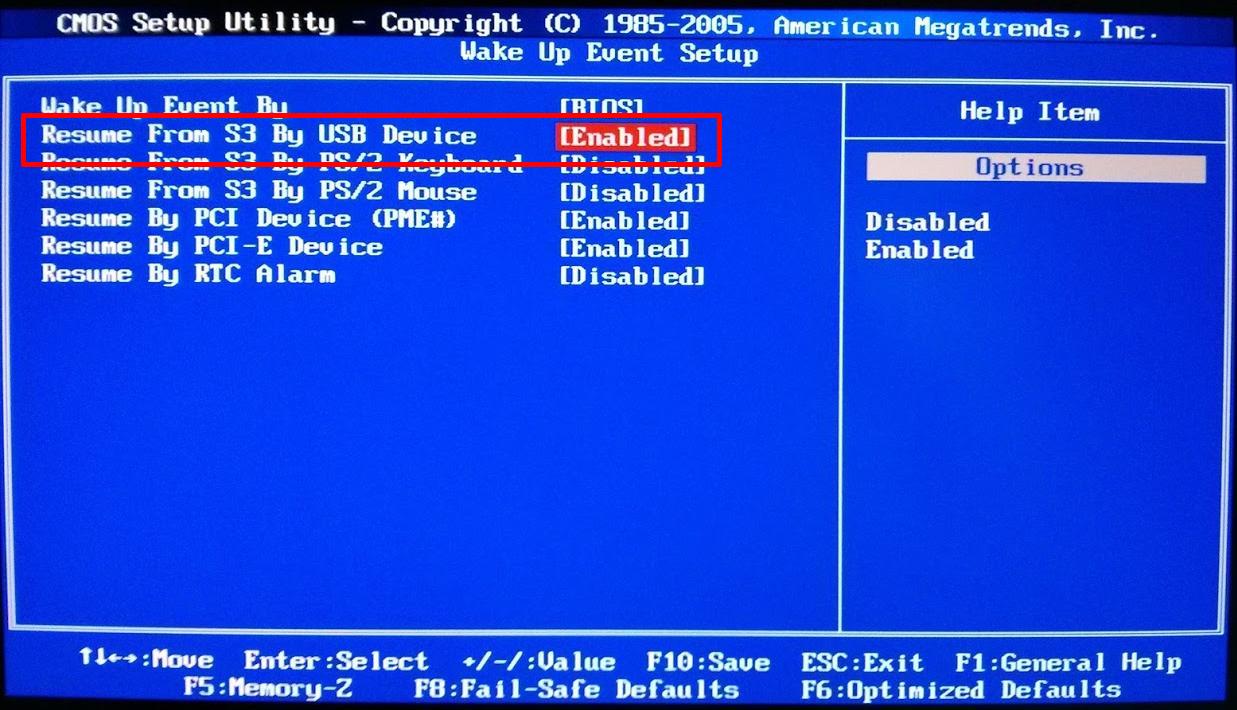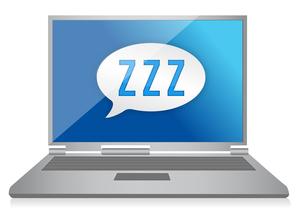
Sleep Mode is very useful for saving battery life on a laptop because saving on electricity is a good thing. More battery juice, longer laptop use. Yey!
It’s also also useful for desktop PC’s. Windows uses Sleep Mode to save the current status of your PC and easily restore it on wake-up. Wake-up is typically achieved with the move of the mouse, or tap of a key on the keyboard.
But sometimes… these ‘wake up’ things you need to do don’t work at all. So what do you do? Let’s begin…
Quick fix: Reboot!
Press the power button for about 10 seconds. That should power down the system completely. Press the power button again to restart it. After that, you can use the tips in this guide to figure out why your Windows 10 PC won’t wake up from Sleep Mode to prevent it from happening again.
Note: you should always try to shut down your system the normal way. Do this force shutdown tip only when necessary. Also, pls. don’t revert to this ‘fix’ as your go to solution for Sleep mode problems. That won’t fix the problem and can harm your system if you do it often.
Is your PC in Sleep or Hibernate mode?
First though, please note that there is a difference between your PC going into Sleep Mode or Hibernate Mode. Both are meant to save power and allow for easy continuation of work by starting Windows faster. In Sleep Mode the computer still uses a little power since the state is stored in RAM (computer memory), while in Hibernate Mode the state is saved to disk (a hibernation file), and then PC turns off.
On a laptop though, even if a computer goes into Sleep Mode, Windows will still go into hibernation mode if the battery runs out.
Waking up from Hibernation mode
Waking up from hibernation not only takes longer, but it also requires different actions. On a laptop, you obviously first want to make sure there is sufficient power, so plug it first to charge the battery.
Opening the lid on your laptop will normally bring Windows back on from hibernation mode. If that does not work, press the power button. On a desktop, the power button should be used.
Waking up from Sleep mode
To wake up a laptop from Sleep Mode you use the same actions as on a desktop (mouse or keyboard). Some PCs have a separate sleep button. If so, you need to press that to wake up the laptop from Sleep Mode.
Ok, say you’ve established that your system is truly into Sleep Mode, and it really won’t wake up. Now what? Read on for the fixes folks!
Check your mouse or keyboard settings
Often, it’s your mouse or keyboard that’s the problem. To fix this, follow these steps.
- Right-click the Start menu button and select Device Manager.
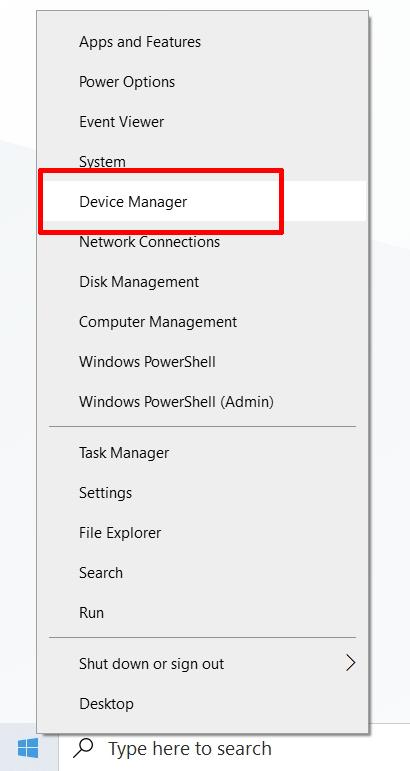
- In Device Manager, you will see a list of device categories. Open the category called Keyboards. (Click the down arrow in front of it).
- Next, right-click your keyboard device in the list, and in the popup menu, select Properties.

- In the keyboard Properties window, select the Power Management tab.
- After that, make sure the checkbox named Allow this device to wake up the computer is selected.
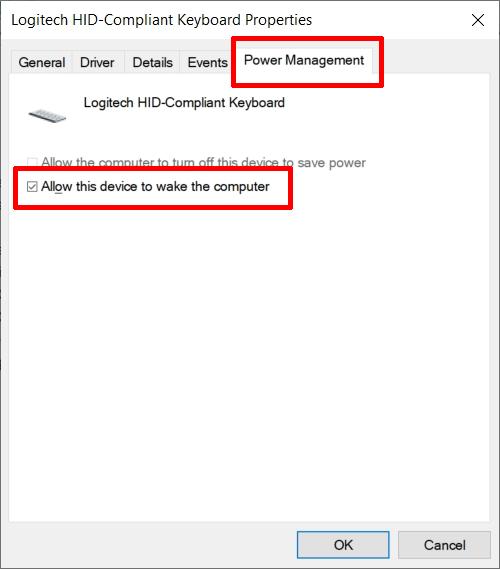
- Click OK to confirm.
- Repeat these steps for the category called Mice and other pointing devices, with your mouse device.
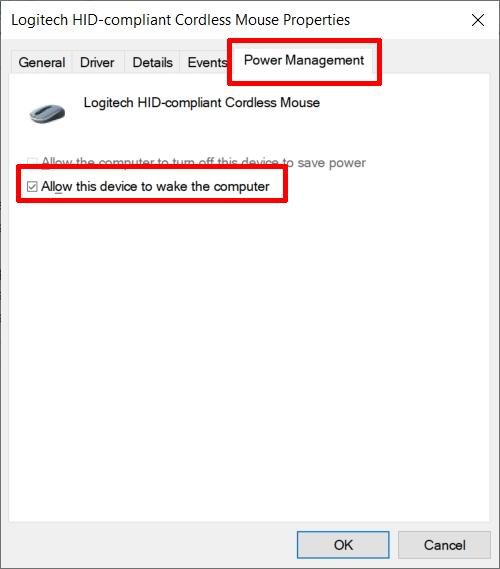
Now try again if you can wake up your Windows 10 PC using the mouse and keyboard. In most cases this should fix the issue. If not, please try the steps below.
- In Device Manager, open the category called Universal Serial Bus controllers.
- Right-click the USB Root Hub device and click Properties.
Note: If there are multiple devices, repeat these steps for each until you have pinpointed the right one. - Select the Power Management tab.
- Now clear or uncheck the checkbox named Allow the computer to turn off this device to save power.
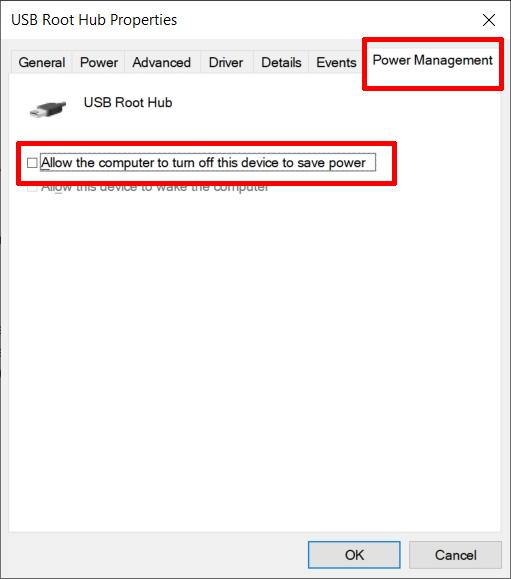
- Click OK to confirm.
This will ensure that the USB port remains powered, so the keyboard and mouse devices will still work when in sleep mode. Even when using a wireless mouse, the receiver is still connected to a USB port.
If you are using a Bluetooth mouse, you might need to perform these steps for the Bluetooth USB module device in the Bluetooth category instead.
Configure your Power Options
To configure which power mode Windows uses, follow these steps.
- Right-click the Start menu button, and click Power Options.
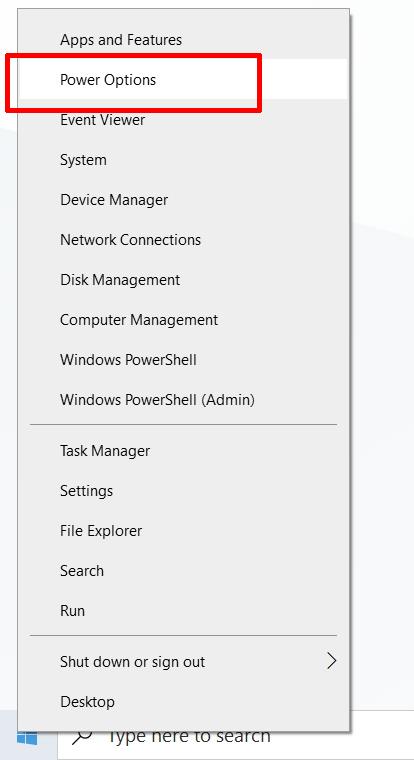
- In the Power Options window, click Choose what the power buttons do.

Note: On a laptop, you can also use the Choose what closing the lid does option. This will show you the same options, but now includes an option for closing the lid and differentiates between On battery and Plugged in modes as shown below.
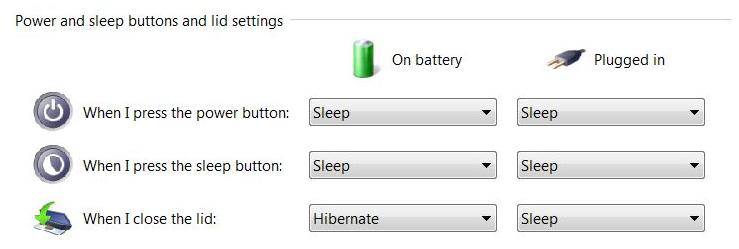
- In the next window, ensure that the option selected next to When I press the sleep button is Sleep. (If not, then change it to Sleep.)
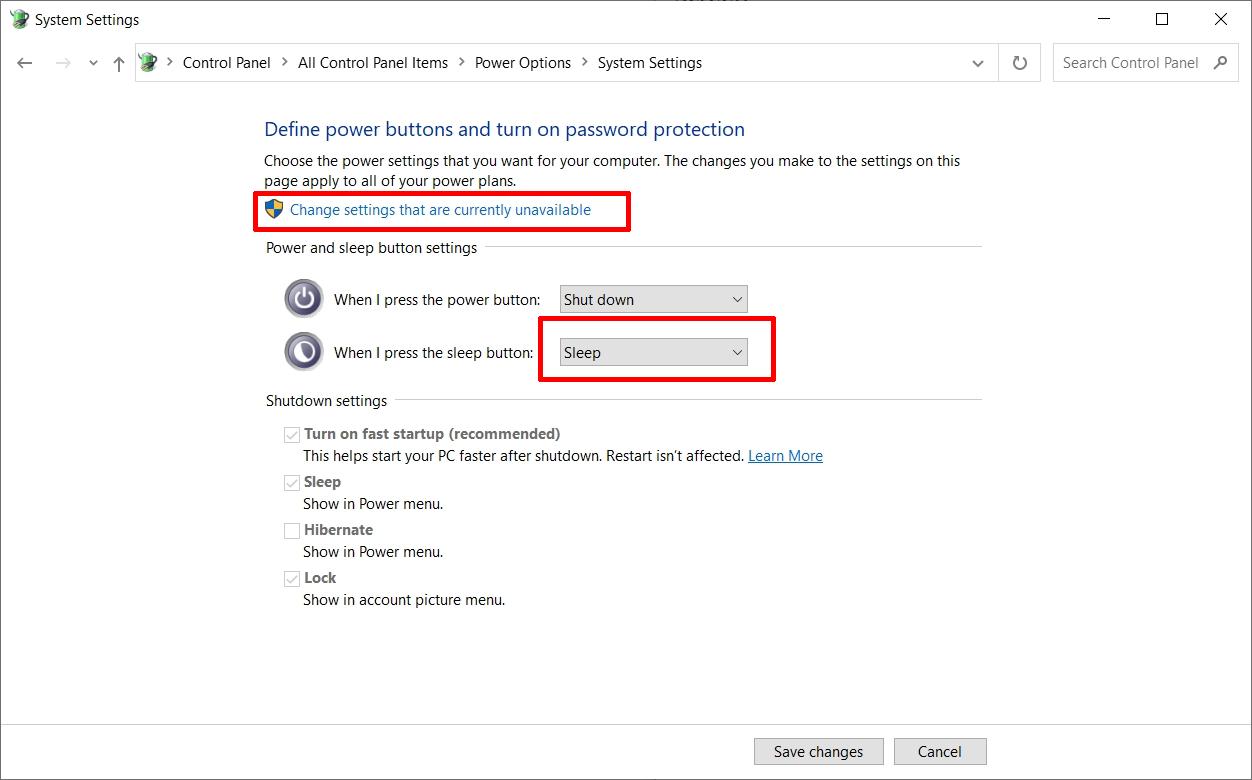
- Next, click Change settings that are currently unavailable. (This will enable the options under Shutdown settings.)
- Clear (uncheck) Turn on fast startup (recommended).
- Click Save changes to confirm and close this window.
Note: If after this change the Windows 10 sleep mode error is not resolved, you can re-enable this option. The Fast Startup option can cause problems, that is why it is mentioned as a tip here to fix wake up problems. But when it is not the cause of the wake up problem, it is beneficial to keep it turned on.
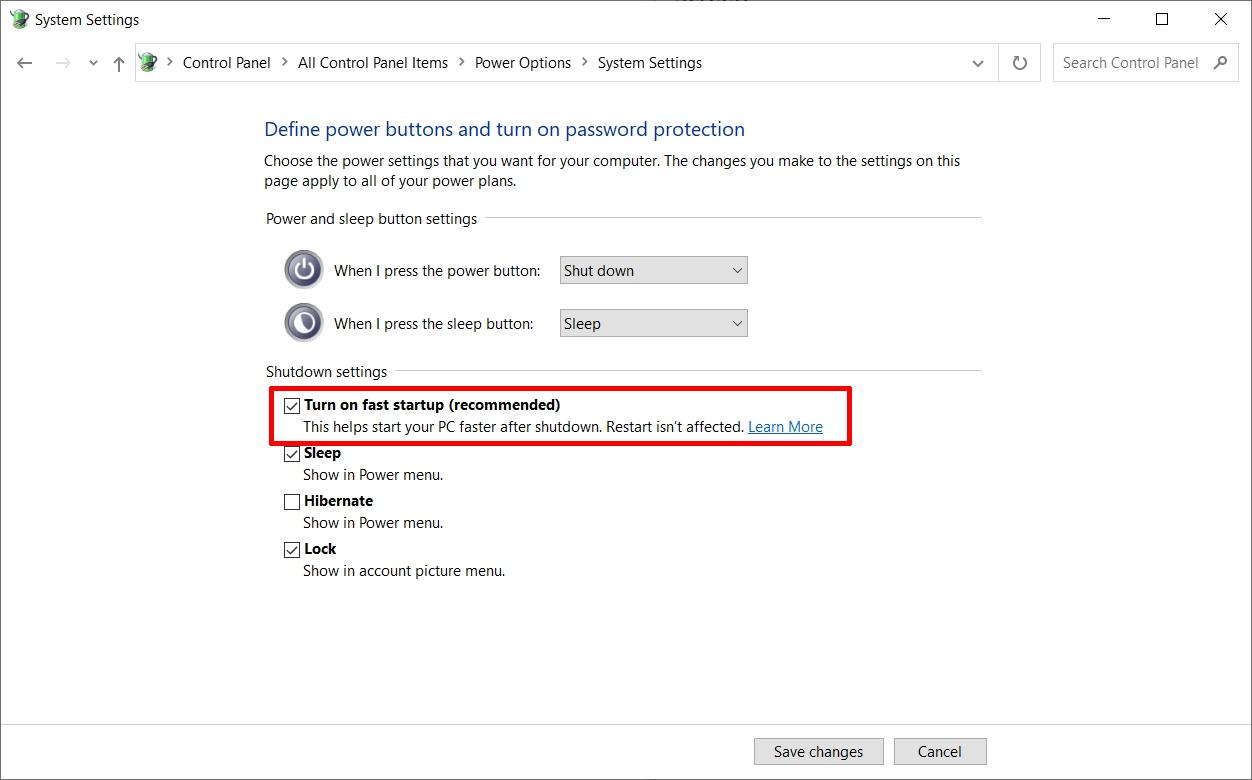
- Back in the Power Options window, click the Change plan settings for the current power plan being used.
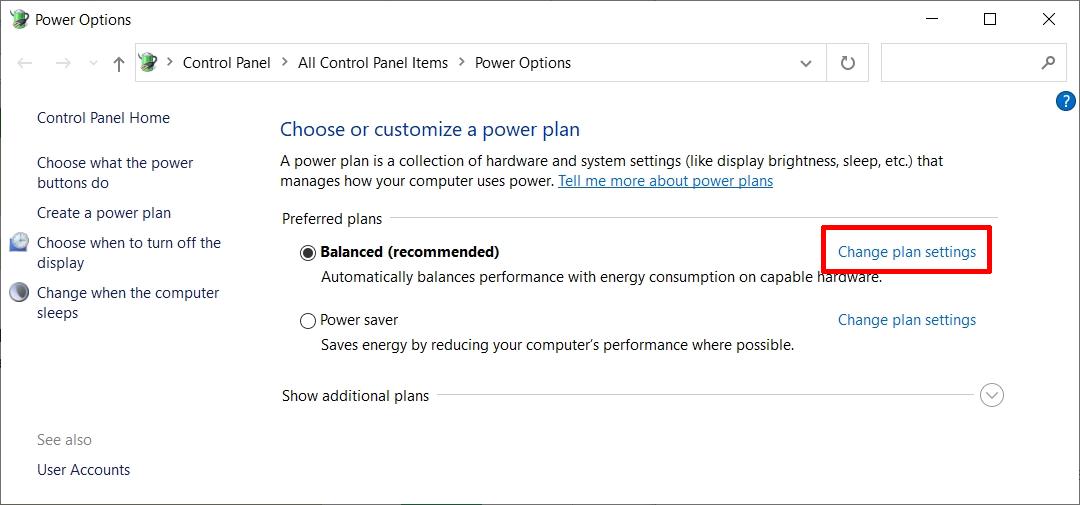
- Now click the Change advanced power settings.

- Verify the settings for Allow hybrid sleep, and Allow wake timers.
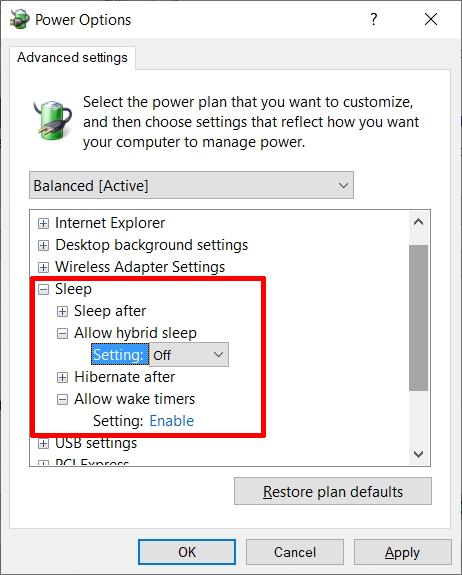
You want to make sure that the Allow hybrid sleep setting is turned Off, and that Allow wake timers is set to Enable. Click the + symbol to open the option and then click the setting to change it. - If these changes still don’t fix your Windows 10 PC won’t wake up from sleep problem, then Disable the USB selective suspend setting.

- A less common setting that can cause issues with Sleep mode in Windows 10 is the multimedia sharing setting.
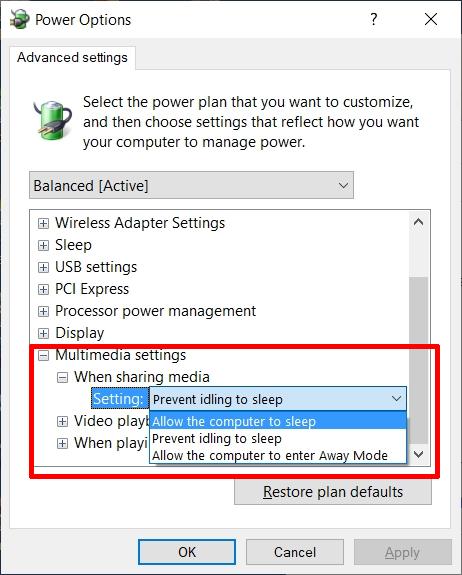
Allow sleep during media sharing Open the Multimedia settings. Click the When sharing media option, and then change the setting to Allow the computer to sleep.
- Click OK to confirm and save the settings.
You may need to restart your PC for the changes to take effect.
Hibernate mode – disable, reboot, enable
If your PC uses the Hibernate option for power saving, it can help to disable and re-enable this option. If none of the previous steps have solved the Windows 10 wake up from sleep problem, it is useful to try this, especially on laptops where Hibernate mode is used frequently.
The easiest way is to use the Advanced settings in the Power Options menu.
- Right-click the Start menu button, and click Power Options.
- Click the Change plan settings for the current power plan being used.
- Click Change advanced power settings.
- Under the Sleep category, open the Hibernate after option and then change the Setting to Never.
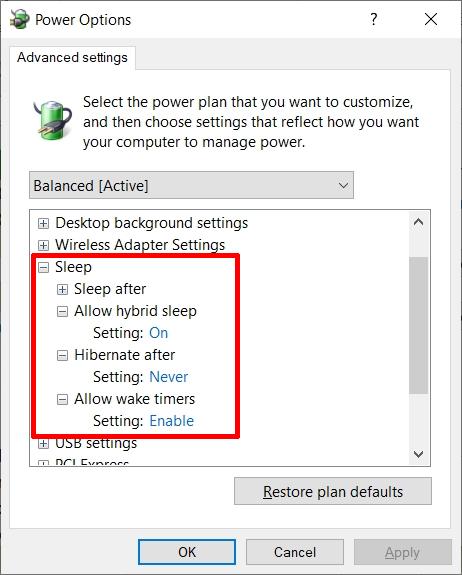
- Click OK to save and confirm.
- Reboot your PC.
- Now re-enable this Hibernate option again, by changing the Setting to the previous value.
Update your device drivers
Windows controls devices using device drivers. This includes the power management control on devices; because of this, it is important to ensure that you have the correct drivers installed for your devices.
You can use the Windows 10 Device Manager to update the drivers individually, or get the latest drivers from the PC manufacturer.
If you don’t have time or the know-how to properly select, download and install the drivers you need, you can try using DriverFinder.
DriverFinder will automatically recognize your system and find the correct and most-updated drivers for it.
- Click here to download and install DriverFinder.
- Click Activate to register your copy of DriverFinder.
- Click Start Scan to check for new drivers.

- Download and install the latest device drivers specifically recommended for your system.

- Restart your PC or laptop.
Check the BIOS resume settings
Ok, this fix is really more for older PC systems. And although Windows 10 is not often run on older computers due to compatibility issues, I still want to mention it here, especially since many of these steps are also useful on troubleshooting the same issue on older Windows versions.
If the above fixes didn’t solve your Windows 10 PC won’t wake up from sleep mode, reboot your PC and go into the BIOS (press Esc, Del, or F2 during startup in most cases).
Look for the settings pertaining to the Resume from S3 By USB Device or something similar, and make sure the setting is Enabled. Please note that the location and name of the option depend on the BIOS version.
Note: If you are using a cabled mouse or keyboard with PS/2 connection (typical the green and purple connectors), then make sure to enable those options in the BIOS as well.
Press the F10 key to save the setting after changing it, and then reboot the computer.
Windows 10 PC won’t wake up from sleep mode – what if the problem is the monitor?
When Windows 10 wakes up from sleep mode, the PC starts, and the screen comes on. So what if the PC starts and it is only the screen that does not power up?
This is not something that would happen with laptops a lot, but in case of a desktop, it is very possible. The PC starts (you can either hear the fans or the hard disk spinning up), but there is no display.
The first thing to try is to simply turn off the monitor, and turn it back on again. This way, you at least know that this is the problem you are dealing with. If that does not work, following are other possible solutions.
Monitor Settings
A common cause of the monitor not waking up from sleep is a setting called “auto-detect” on the monitor. This setting helps the monitor detect the signal on the connections and use the proper input for the video signal. Go into your monitor settings and disable this feature. After that try the wake up from sleep mode again and see if it is fixed.
Note: Instructions for this will vary a lot depending on the monitor type. In most cases there will be buttons on the monitor on the bottom or side of the monitor to access the settings.
More Power Settings
Windows 10 has some more advanced Power Options that control how power is saved and restore to the PC hardware. A setting that can affect the graphics card, and thus the monitor, is called Link State Power Management in the PCI Express category.
Disable this option with these steps:
- Open Power Options from the Control Panel.
- Select the option Change plan settings for the current power plan.
- Next, click the Change advanced power settings
- In the Power Options dialog box, in the Advanced Settings tab, scroll down to the PCI Express entry and click the + sign to open it.
- Now click Link State Power Management, and clickSetting to change it to Off.
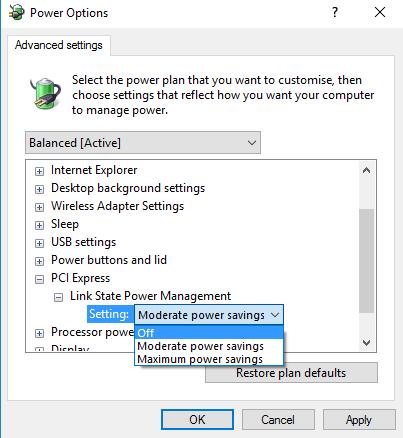
- Click OK to confirm, and close the open windows.
After this, try putting the computer to sleep again and wake it up to check if the monitor comes on as well.
Trigger the graphics driver to rebuild the screen
If the permanent settings in the earlier steps do not help with the problem of waking up the monitor, then triggering the graphics driver to refresh the screen could help.
This is actually a Microsoft recommended solution to deal with a black screen problem. Simply press the Windows Logo + Ctrl + Shift + B keys all at the same time.
The computer might beep, and the screen flash, but hopefully the monitor will show your Windows Desktop again.
This solution has been introduced with Windows Vista, when the Desktop Window Manager (DWM) was added to Windows. It acts like a graphics reset.
Check the monitor cable
This might seem like an odd suggestion. But it is definitely possible to have a defect or non-standard cable that causes the problem of the monitor not waking up on a Windows PC. If you have tried all other solutions, do consider this option too. Ideally, try a cable from which you know it works correctly on a different system.
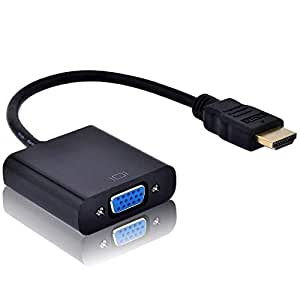
If you are using a converter for your PC display output to the monitor display input, you should also check it. Converters from Display Port, HDMI, DVI and VGA (and vice versa) are not always compatible with the power options offered by Windows 10.
- PCI Encryption/Decryption Controller Drivers for Windows 10 - February 16, 2025
- WD Passport Drives and How to Use Them with Windows 10: A Complete Guide - November 14, 2024
- How to Fix Unknown USB Device – Device Descriptor Request Failed - May 8, 2024

